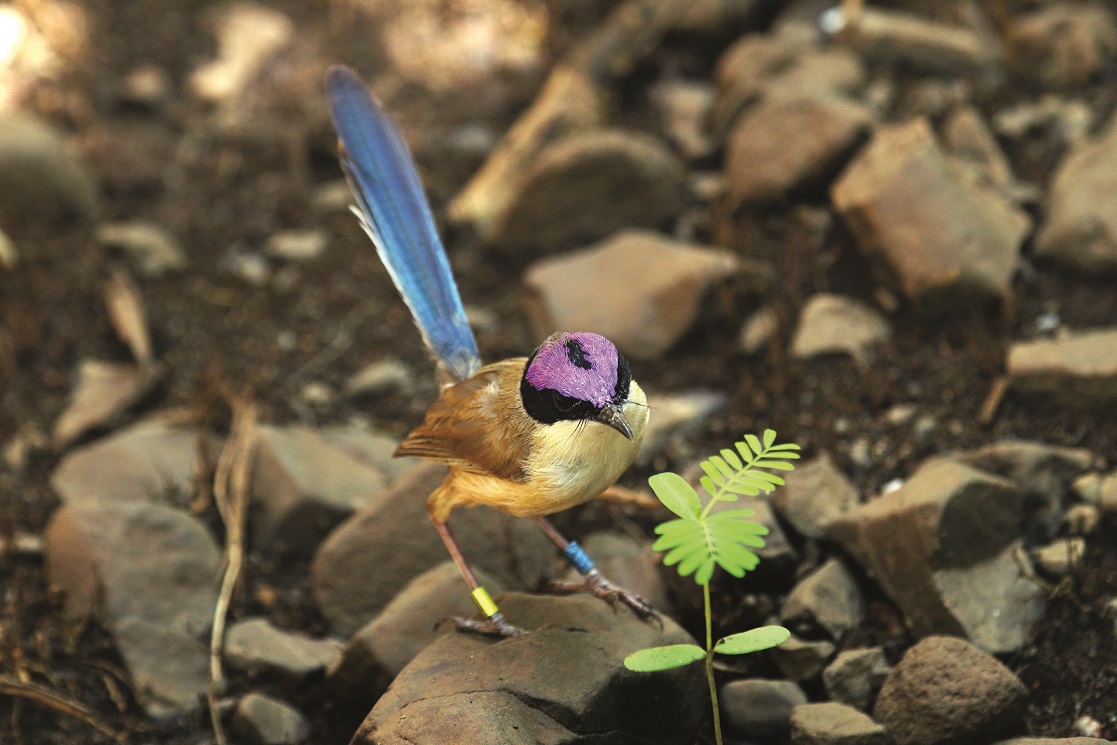By Dr Niki Teunissen, Postdoctoral Research Fellow, Monash University, and Dr Anne Peters, Associate Professor, Monash University, in collaboration with AWC ecologists
Fairywrens have fascinated researchers for a long time, and for good reason – males tend to display striking seasonal breeding plumages, and wrens live in social groups that breed cooperatively, seemingly going against the evolutionary principle that individuals should be selfish and only care for their own progeny.
With its stunning purple head and perky blue tail, the Purple-crowned Fairywren represents an iconic species of the Kimberley. It is a riparian habitat specialist occurring only along waterways in northern Australia. The western subspecies, Malurus coronatus coronatus, is endangered because its riparian habitat, specifically Pandanus aquaticus vegetation, is suffering from habitat degradation due to feral herbivores and fire.
Purple-crowned Fairywrens at Mornington
To better understand the species and how we might help conserve it, Associate Professor Anne Peters, from Monash University, in collaboration with AWC, set up a long-term research project in 2005 to study Purple-crowned Fairywrens at AWC’s Mornington Wildlife Sanctuary. Still ongoing, the project involves close monitoring of a population along 15 kilometres of Annie Creek and Adcock River.
Here, AWC’s destocking efforts and implementation of the EcoFire program have allowed the riparian vegetation to regenerate, and the fairywren population to thrive. In fact, the Purple-crowned Fairywren population at Mornington has the highest density in its range.
All fairywrens in the population have been fitted with small, uniquely coloured leg bands. The researchers have followed individuals throughout their lives and know exactly where and when each local bird was born, where it moved to, which bird it mated with, how many offspring it had, and ultimately, when it died.
 © Niki Teunissen/AWC
© Niki Teunissen/AWC
Research findings
This research has yielded some exciting insights into the life of Purple-crowned Fairywrens. For example, unlike other fairywrens that are renowned for their promiscuity, Purple-crowned Fairywrens are very faithful. Possibly, this is because their territories are arranged linearly along the creek rather than as a mosaic, so there are fewer neighbours to potentially cheat with.
In other species, the males’ bright plumage functions to attract females to cheat on their partner. Since Purple-crowned Fairywrens are faithful, their purple plumage serves a different function – to make males more competitive with other males for fiercely contested breeding positions.
The researchers have learned a lot about the social behaviour of the wrens, too. The breeding pair works together with ‘helpers’ in the group to raise young and defend against predators such as goannas, snakes and goshawks. Our research reveals these helpers are not acting purely altruistically but are, in fact, calculated accountants. They only help young likely to return the favour in the future, and they only help birds they might breed with in the future, or breeders that are relatives.
Our understanding of breeding success has also improved. We know now that rainfall triggers breeding; females lay eggs in the first few weeks after rain so the peak in insect (i.e., food) abundance coincides with the presence of dependent fledglings. Most important for breeding success is high quality riparian habitat.
Pairs living on territories with dense pandanus are less likely to have their nest depredated or washed away by floods. High temperatures, on the other hand, limit breeding success; chicks growing up in hot temperatures show evidence of damage to their chromosomes (DNA) and this may reduce lifespan and fitness. Since temperatures are rising with climate change, we are focusing our research on the effect of heat stress on the birds and whether the quality of riparian habitat may buffer its effect.
Looking forward
Following AWC’s destocking of the property, regeneration of riparian habitat has been paired with a steady population increase, from 2005 to 2017. The last two years, however, have been challenging for the species, with the population declining by 51 per cent – most likely owing to two severely dry years causing poor breeding success, combined with the impacts of fire. With more than 100 birds still in the population and AWC’s management of key threats, we are optimistic numbers will soon recover. In August, many birds on Annie Creek were observed to have bred successfully. Breeding is very unusual at this time of year and this success is testament to the flexibility of the wren’s breeding schedule. Close monitoring of the population will help track population health, provide important data on how the wrens recover after drought and fire, and inform AWC’s ongoing management to safeguard the future of the species. Happily, in August-September 75 per cent of breeding pairs have managed to breed successfully or are still actively breeding.
Read and download this full issue of Wildlife Matters here.
Help us protect rare species like the Purple-crowned Fairywren